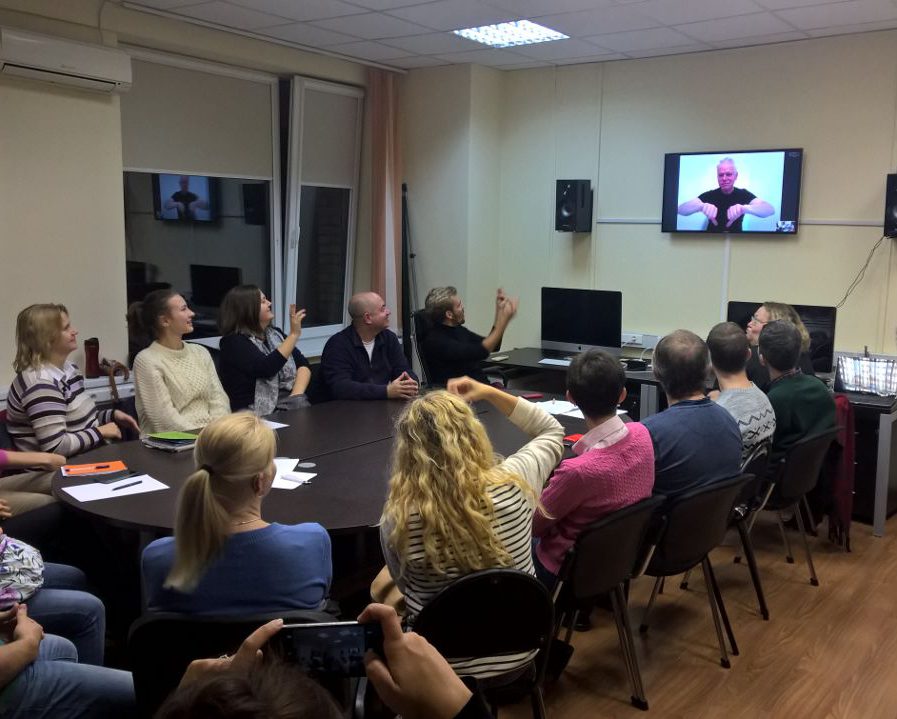
BILINGUALISM IN SIGN LANGUAGE AND IN SPOKEN LANGUAGE: A STUDY OF BRAIN PLASTICITY
(supported by the Russian Science Foundation, grant № 16-18-00070)
BILINGUALISM IN SIGN LANGUAGE AND IN SPOKEN LANGUAGE: A STUDY OF BRAIN PLASTICITY
(supported by the Russian Science Foundation, grant № 16-18-00070)
This project is aimed at the scientific challenge which is directly relevant to one of the fundamental questions of the present day – the connection between language and the brain. Representatives of many disciplines work within these frames, including linguists.
There is much current interest in the benefits of bilingualism for the brain. These include delayed onset of dementia and enhanced executive function. The reason for this advantage has been attributed to increased executive function skills because of the need to inhibit one language when using the other. The study of unimodal and bimodal bilingualism in deaf and hearing individuals will help us to go deeply into the study of Russian sign language and learn the impact of different types of modality at the brain plasticity.
 Most of our knowledge about the neurobiological bases of language comes from studies of spoken languages. The proposed project seeks to explore unimodal and bimodal bilingualism in fluent deaf and hearing bilinguals in relation to brain plasticity.Contrasts have been drawn in the literature between unimodal bilingualism (two spoken languages or two sign languages) and bimodal bilingualism (sign language and spoken language). The possibility of co-articulating (code-blending) two languages when they are in different modalities (for example, speaking or whispering while signing; or producing signs to accompany speech) means that there is no need to inhibit one language while using the other. However, studies to date have primarily been done on hearing cross-modal bilinguals. Although they can mix the two languages, deaf cross-modal bilinguals produce and perceive both their languages in the visual modality.
Most of our knowledge about the neurobiological bases of language comes from studies of spoken languages. The proposed project seeks to explore unimodal and bimodal bilingualism in fluent deaf and hearing bilinguals in relation to brain plasticity.Contrasts have been drawn in the literature between unimodal bilingualism (two spoken languages or two sign languages) and bimodal bilingualism (sign language and spoken language). The possibility of co-articulating (code-blending) two languages when they are in different modalities (for example, speaking or whispering while signing; or producing signs to accompany speech) means that there is no need to inhibit one language while using the other. However, studies to date have primarily been done on hearing cross-modal bilinguals. Although they can mix the two languages, deaf cross-modal bilinguals produce and perceive both their languages in the visual modality.
The goals set in this project are defined by the necessity of studying bilingualism in deaf and hearing people and by the character of language data, including specific traits of sign languages and detected differences in zones of activation in sign language communication process. The goals set are achieved by using a complex of linguistic, psycholinguistic and neuroscience approaches which let to study neurobiological organization of deaf people’s speech system who use sign language in the process of communication. Neural plasticity is examined in the real-time mode with experimental methods with the use of functional magnetic resonance imaging.
The results obtained will enable developing new and more effective methods of habilitation of patients with neurological conditions and can serve as a basis for language and modality typology. The proposed research has both theoretical significance and vital practical applications. It can provide the foundation for new approaches to the mechanisms of neural plasticity of the deaf brain which have to be taken into account in language teaching. As the mechanism of structural plasticity forms the basis of learning, its more in-depth and detailed study will contribute to more effective language teaching as well as ensure better access of the deaf to vocational and higher education.
